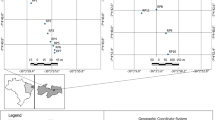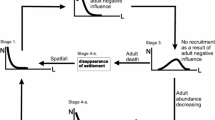Abstract
Little is known about the population structure and dynamics of plankton of intertidal rock pools. A numerical model was developed for rock pool plankton with growth limited by both tidal washout and the stress associated with adverse conditions in high-shore pools. This model predicts that a stress tolerant species will tend to have maximum population densities in high-shore pools and that populations will fluctuate in opposite phase to the spring-neap tidal cycle. Conversely, where a species is susceptible to stress in high-shore pools, the maximum population density is likely to occur lower on the shore, and numbers in upper shore pools will cycle in phase with the spring-neap cycle. These two alternative predictions were sufficient to classify the dynamics of the most abundant species in time series taken from rock pools in the Isle of Man. The dinoflagellate Oxyrrhis marina followed the predictions of the stress tolerant model. In comparison, the spatiotemporal patterns of other taxa, including a ciliate, a dinoflagellate and cryptophytes, suggested stress-susceptible life histories.
Similar content being viewed by others
References
Begon, M., J. L. Harper & C. R. Townsend, 1996. Ecology. Individuals, Populations and Communities. Blackwell Science, Oxford: 1068 pp.
Blackwell, J. R. & D. J. Gilmour, 1991. Stress tolerance of the tidal pool chlorophyte Chlorococcum submarinum. Brit. J. Phycol. 26: 141–147.
Chatfield, C., 1996. The Analysis Of Time Series. An Introduction. 5th Edition. Chapman and Hall, London: 283 pp.
Cousens, R., 1988. Misinterpretations of results in weed research through inappropriate use of statistics. Weed Res. 28: 281–289.
Dawkins, H. C., 1983. Multiple comparisons misused: why so frequently in response curve studies? Biometrics 39: 789–790.
Dethier, M. N., 1980. Tidepools as refuges: predation and the limits of the harpacticoid copepod Tigriopus californicus (Baker). J. exp. mar. Biol. Ecol. 42: 99–111.
Droop, M. R., 1953. On the ecology of flagellates from some brackish and fresh water rockpools of Finland. Acta bot. fenn. 51: 3–52.
Droop, M. R., 1970. Nutritional investigation of phagotrophic Protozoa under axenic conditions. Helgoländer Meeresunters. 20: 272–277.
Faure-Fremiet, E., 1948. The ecology of some infusorian communities of intertidal pools. J. anim. Ecol. 17: 127–130.
Harris, G. P. & A. M. Trimbee, 1986. Phytoplankton population dynamics of a small reservoir: physical/biological coupling and the time scales of community change. J. Plankton Res. 8: 1011–1025.
Hasle, G. R., 1976. The inverted microscope method. In Sournia, A. (ed.), Phytoplankton Manual. Monographs on Oceanographic Methodology 6. UNESCO, Paris: 88–96.
Jonsson, P. R., 1994. Tidal rhythm of cyst formation in the rock pool ciliate Strombidium oculatum Gruber (Ciliophora, Oligotrichida): a description of the functional biology and an analysis of the tidal synchronization of encystment. J. exp. mar. Biol. Ecol. 175: 77–103.
Metaxas, A. & A. G. Lewis, 1992. Diatom communities of tidepools: the effect of intertidal height. Bot. Mar. 35: 1–10.
Metaxas, A. & R. E. Scheibling, 1993. Community structure and organization of tidepools. Mar. Ecol. Prog. Ser. 98: 187–198.
Metaxas, A. & R. E. Scheibling, 1996. Spatial heterogeneity of phytoplankton assemblages in tidepools: effects of abiotic and biotic factors. Mar. Ecol. Prog. Ser. 130: 179–199.
Parsons, T. R., Y. Maita & C. M. Lalli, 1984. A Manual of Chemical and Biological Methods for Seawater Analysis. Pergamon Press, Oxford: 173 pp.
Perry, J. N., 1986. Multiple comparison procedures: a dissenting view. J. econ. Entomol. 79: 1149–1155.
Pfister, C. A., 1998. Extinction, colonization and species occupancy in tidepool fishes. Oecologia 114: 118–126.
Powlik, J. J., 1998. Seasonal abundance and population flux of Tigriopus californicus (Copepoda: Harpacticoida) in Barkley Sound, British Columbia. J. mar. biol. Ass. U.K 78: 467–481.
Sephton, D. H. & G. P. Harris, 1984. Physical variability and phytoplankton communities: VI. Day to day changes in primary productivity and species abundance. Arch. Hydrobiol. 102: 155–175.
Southward, A. J., 1953. The ecology of some rocky shores in the South of the Isle of Man. Proc. Transact. Liverpool Biol. Soc. 59: 1–50.
Underwood, A. J. & G. A. Skilleter, 1996. Effects of patch size on the structure of assemblages in rock pools. J. exp. mar. Biol. Ecol. 197: 63–90.
Rights and permissions
About this article
Cite this article
Johnson, M.P. Physical control of plankton population abundance and dynamics in intertidal rock pools. Hydrobiologia 440, 145–152 (2000). https://doi.org/10.1023/A:1004106808213
Issue Date:
DOI: https://doi.org/10.1023/A:1004106808213




